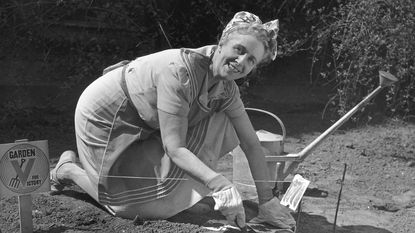Gardening History - Story Behind Victory Gardens


Whether you're a history buff or not, you've likely heard of Victory Gardens at some point. This is one part of our nation's history that I'm actually quite proud of, especially since I'm a gardener. The story of Victory Gardens is an interesting one, and with current events keeping many of us at home these days, you may want to consider planting a food garden like this for your family and community.
What are Victory Gardens?
In simple terms, these were vegetable gardens grown by average citizens during the World War era. Similar patriotic type gardens were grown during WWI, but it wasn't until WWII that the name Victory Gardens was introduced as a practical way to contribute to the war effort.
The U.S. government asked its citizens to plant their own vegetable gardens to help with food shortages, and they responded. Nearly 20 million families grew around 40 percent of our country's vegetables by 1944 - mine included and probably yours too.
Victory Garden History
Victory Gardens were a continuation of the war gardens aimed at reducing food shortages during the first World War. Not only did those here at home rely on food, but our military and even some of its allies did as well. Since canned fruits and veggies were rationed during this time, civilians were encouraged to grow their own produce to supplement their needs, stretching their ration coupons, and prevent possible hoarding of food.
Shortly after the United States entered World War II, promotion of Victory Gardens began with numerous pamphlets handed out to guide urban and suburban gardeners. A number of magazines and newspapers published helpful articles, and patriotic posters went out urging participation. The U.S. government even printed recipe books on preparing homegrown vegetables for meals. This huge media campaign proclaimed that "Food will win the war."
These gardens were grown all over the United States, and women were particularly encouraged to plant Victory Gardens in their yards while their husbands were off fighting. You could find these gardens in all shapes and sizes, much like today. People grew Victory Gardens on farms, in backyards, on city rooftops, or in window boxes. Community gardens were planted in parks and vacant lots, and many schools had their own gardens which provided fresh vegetables for school lunches.
Basically, anything could be grown in a Victory Garden. Whatever fruits, vegetables, and herbs were necessary to supplement food was grown. Most common were vegetables like tomatoes, carrots, lettuce, beets, and peas. Interestingly, it was thanks to Victory Gardens that both Swiss chard and kohlrabi became popular, as they're easy to grow. Much of the produce was preserved for winter, and there was no shortage of women's magazines having articles about how to can, store, dry, pickle, and freeze one's harvest. Communities were also encouraged to share their surplus with others.
Gardening tips, videos, info and more delivered right to your inbox!
Sign up for the Gardening Know How newsletter today and receive a free download of our most popular eBook "How to Grow Delicious Tomatoes."
My own family took part in this, and my mom remembers stories about the family growing food to supplement rationing. And, while I could not find any specific information on troops growing their own food, I managed to come across an old photo of my grandfather in a garden during WWII with other soldiers. If anyone would have been gardening, it most certainly would have been him. He could grow just about anything. There was also a community garden associated with Euclid Beach, near where my mother grew up in Ohio. The park grew watermelons on their popcorn farm and auctioned them off to help raise funds and feed others at the same time.
Growing Victory Gardens gave Americans a feeling that they were doing something helpful. I take pride in knowing that my family participated. Wouldn't it be nice if we could all do this naturally, without any war or quarantine"¦ just because. Think of all the people we could help while doing what so many gardeners enjoy anyway.
The story behind Victory Gardens is an interesting one and you can celebrate this Victory Garden history by growing your own World War II era garden, or any type of veggie garden, with heirloom plants of the time, or grow your favorites. Planting a food garden is a rewarding endeavor. And don't forget to help your neighbors by sharing your surplus with others in the community!

Nikki Tilley has been gardening for nearly three decades. The former Senior Editor and Archivist of Gardening Know How, Nikki has also authored six gardening books.
-
 10 Best Apartment Plants To Turn Your Small Space Into An Oasis
10 Best Apartment Plants To Turn Your Small Space Into An OasisThe best apartment plants can lend an ambience of the tropics, brighten up a space, or add a touch of drama, and turn an apartment into a relaxing oasis.
By Amy Grant
-
 Grow a Bathroom Oasis: 8 Best Bathroom Plants With No Light or Low Light
Grow a Bathroom Oasis: 8 Best Bathroom Plants With No Light or Low LightSome apartment dwellers grow the best bathroom plants with no light or low light. Read how one of our favorite plant lovers does it in the big city.
By Teo Spengler